初一上册英语语法总结
初一上册英语语法大全

初一上册英语语法大全【1 】一. 动词be(is,am,are)的用法我(I)用am, 你(you)用are,is跟着他(he).她(she).它(it).单数名词用is,复数名词全用are.变否认,更轻易,be后not加上去.变疑问,往前提,句末问号莫丢弃.还有一条须留意,句首大写莫忘却.二. this,that和it用法(1)this和that是指导代词,it是人称代词.(2)距离措辞人近的人或物用this, 距离措辞人远的人或物用that.如:This is a flower. 这是一朵花.(近处)That is a tree. 那是一棵树.(远处)(3)放在一路的两样器械,先说this, 后说that.如:This is a pen. That is a pencil. 这是一支钢笔.那是一支铅笔.(4)向他人介绍或人时说This is…, 不说That is….如:This is Helen. Helen, this is Tom. 这是海伦.海伦,这是汤姆.(5)This is 不克不及缩写, 而That is可以缩写.如:This is a bike. That’s a car. 这是一辆自行车.那是一辆轿车.(6)打德律风时,介绍本身用this, 讯问对方用that.如:—Hello! Is that Miss Green? 喂,是格林蜜斯吗?—Yes, this is. Who’s that? 是的,我是,你是谁?留意:固然汉语中应用“我”和“你”,但英语中打德律风时毫不成以说:I am…, Are you…?/Who are you?(7)在答复this或that作主语的疑问句时, 要用it代替this或that.如:①—Is this a notebook? 这是笔记本吗?—Yes, it is. 是的,它是.②—What’s that? 那是什么?—It’s a kite. 是只风筝.三. these和those用法this, that, these和those是指导代词,these是this的复数情势,指时光.距离较近的或下面要提到的人或事;those是that的复数情势,指时光.距离较远或前面已经提到过的人或事物.①This is my bed. That is Lily’s bed. 这是我的床.那是莉莉的床.②These pictures are good. 那些画很好.③ Are those apple trees? 那些是苹果树吗?在答复主语是these或those的疑问句时,通经常应用they代替these或those 以防止反复.如:④Are these/those your apples? 这些(那些)是你的苹果吗?Yes, they are. 是的,他们是.四. 不定冠词a和ana和an都是不定冠词,暗示一(个,支,本,块……)的意思,但不强调数目概念,而是强调类别,用来限命名词.a用在子音音素开首的单数名词前,如:a pencil(一支铅笔),a book(一本书);an用在元音音素开首的名词前,如an eraser(一块橡皮).假如名词前有润饰语,用a照样用an,则以该润饰语的第一音素决议用a照样用an.如:a clock 一座钟an old clock 一座旧钟a book 一本书an English book 一本英语书a nice apple 一个讨厌的苹果an apple 一个苹果六. There be句型(1)There be句型重要用以表达“某处(某时)有或人(某物).”其根本构造为“There be+某物(或人)+某地(某时)”个中there是引诱词,没有词义;主语是be后面的名词, be是谓语动词,在一般如今时中be只用is和are两种情势.下面这首歌诀可帮你巧记there be句型构造:There be放句首,主语跟在后.地.时放句末,强调置前头.如:There is a book on the desk.有时为了强调地点,也可把介词短语放在句首.如:On the desk there is a book.(2)There be句型中的be动词若何肯定呢?请先看看下面这首歌诀:Be动词,有三个,am,is还有are.“There be”真特别,不留am只留俩,那就是is还有are.要用is照样are,须看厥后的名词是单数照样复数.若是单数或不成数名词用is,不然就用are.如:①There is a tree behind the house.②There is some water(水)in the bottle(瓶子).③There are some pears in the box.(3)留意:假如“be”后的主语是由and衔接的两个或两个以上的名词,那么be 的情势要遵守“远亲不如近邻”的原则.也就是说,“be”的情势是由与它比来的谁人名词来肯定的.若谁人名词是单数或不成数名词要用is,是复数就用are.如:①There is a book and some pens on the floor.②There are some pens and a book on the floor.七. 一般如今时一般如今时暗示经常性.习惯性的动作,或暗示如今的特点.状况.八. 句子单数变复数,留意以下五要素(1)主格人称代词要变成响应的复数主格人称代词,即I→we, you→you,she,he,it→ they.如:She is a girl. →They are girls.(2)am,is要变成are.如:I’m a student. →We are students.(3)不定冠词a,an要去失落.如:He is a boy. →They are boys.(4)通俗单数名词要变成复数情势.如:It is an apple. →They are apples.(5)指导代词this,that要变成these,those.如:This is a box. →These are boxes.九. 英语日期的暗示法英语中月份和礼拜名称都是专著名词,它们的首字母必须大写,并且前面无需用冠词.用英语暗示日期,其次序为月+日+年,日和年之间需用逗号离隔.如:August2nd,2003(2003年8月2日).也可以用日+月+年来暗示.如:10th May,2003(2003年5月10日).英语日期前介词的应用:若指在哪一年或哪一月,则用介词in,若具体到某一天,则需用介词on.如:①She was born in 1989②She was born in August.③She was born in August 1989.④She was born on 2nd August, 1989.十. 名词单数变复数在英语里面,名词分可数名词(countable noun)和不成数名词(uncountable noun).不成数名词没有单复数之分,用时只当单数词用;可数名词有单复数之分,一个的前面要用a或an,eg: a pencil, a basketball, a dictionary, an egg, an ID card,而复数即两个或两个以上的要作响应的变更,情形如下:(1)一般的词在单数词后直接+“s”book→books,pen→pens,car→cars,map→maps,cartoon→cartoons(2)以s,x,sh,ch结尾的词+“es”box→boxes,watch→watches(3)以子音字母+y结尾的名词去失落“y”,改成“i”,再加“es”family→families,comedy→comedies(4)以f或fe结尾的词,先去失落f或fe,改成“v”再加esknife→knives,wife→wives,handkerchief→handkerchieves(5) 特别词,特别变更,需单独记:child→children,man→men,foot→feet,woman→womentooth→teeth,sheep→sheep,deer→dee r十一. 时光的表达法(1)直读式,即直接读出时光数字7: 05 seven five8:16 eight sixteen(2) 过.差式,即几点差几分,几点过几分.(以30分为分界限)1:25 twenty-five past one2:30 half past two3:43 seventeen to four4:38 twenty-two to five(3)12小时制6:00 a.m. 上午6点8:20 p.m. 下昼8点20分(4)24小时制13:00 13点钟22:15 22点15分(5)15分可用quarter4:15 a quarter past four5:45 a quarter to six(6)时光前通经常应用介词atat 5 o’clockat 7:30 p.m.十二. 关于时光的问法(1)以when提问,“什么时刻”可所以较长的时光段,也可所以较短的时光点,如:①When is your birthday? 你的诞辰是什么时刻?②My birthday is Dec. 29th. 我的诞辰是12月29日.这里就是指一天的时光段①When do you go home? 你几点回家?②I go home at 4:30 p.m. 我下昼4:30回家.这里when问的是具体的时光.(2)具体几点我们通经常应用what time提问,如:①What time is it now?/What’s the time now?如今几点了?It’s 9:26. 如今九点二十六.②What time is it by your watch? 你手表几点了?It’s 8:36. Oh, It’s 50 minutes late. 8:36,哦,它慢了50分钟.③What time do you get up? 你几点起床?I get up at 6:00 a.m. 我早上6点起床.。
初一英语上册语法知识点总结归纳

初一英语上册语法知识点总结归纳
- 一般现在时:表示经常发生的动作或存在的状态。
句式结构:主语+动词+其他。
当主语是第三人称单数时,动词要用第三人称单数形式。
- 现在进行时:表示正在进行或发生的动作。
句式结构:主语+be 动词+动词 ing+其他。
- 一般过去时:表示过去发生的动作或存在的状态。
句式结构:主语+动词过去式+其他。
- 一般将来时:表示将来发生的动作或存在的状态。
句式结构:主语+will+动词原形+其他,或主语+be going to+动词原形+其他。
- There be 句型:表示某地有某物或某地存在某物。
句式结构:There is/are+主语+地点状语。
- 形容词的比较级和最高级:用于比较两个或两个以上的人或事物。
比较级用于两者之间的比较,最高级用于三者或三者以上的比较。
- 代词:包括人称代词、物主代词、反身代词等,用于代替名词或起到连接作用。
- 冠词:包括定冠词 the 和不定冠词 a/an,用于修饰名词,特指或泛指某个人或事物。
- 介词:用于表示时间、地点、方位、方式等,常见的介词有 in、on、at、for、with、by 等。
- 数词:包括基数词和序数词,用于表示数量和顺序。
- 陈述句、疑问句、祈使句和感叹句:陈述句用于陈述事实或观点,疑问句用于提出问题,祈使句用于表示请求、命令、建议等,感叹句用于表示感叹语气。
初一英语上册语法知识点总结
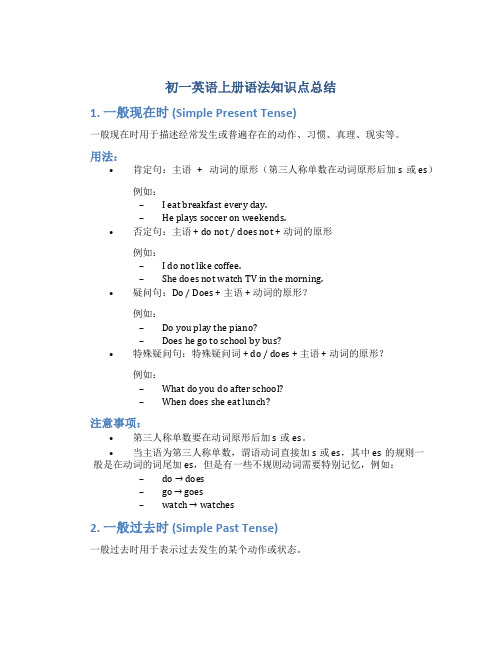
初一英语上册语法知识点总结1. 一般现在时 (Simple Present Tense)一般现在时用于描述经常发生或普遍存在的动作、习惯、真理、现实等。
用法:•肯定句:主语+ 动词的原形(第三人称单数在动词原形后加s或es)例如:–I eat breakfast every day.–He plays soccer on weekends.•否定句:主语 + do not / does not + 动词的原形例如:–I do not like coffee.–She does not watch TV in the morning.•疑问句:Do / Does + 主语 + 动词的原形?例如:–Do you play the piano?–Does he go to school by bus?•特殊疑问句:特殊疑问词 + do / does + 主语 + 动词的原形?例如:–What do you do after school?–When does she eat lunch?注意事项:•第三人称单数要在动词原形后加s或es。
•当主语为第三人称单数,谓语动词直接加s或es,其中es的规则一般是在动词的词尾加es,但是有一些不规则动词需要特别记忆,例如:–do → does–go → goes–watch → watches2. 一般过去时 (Simple Past Tense)一般过去时用于表示过去发生的某个动作或状态。
用法:•肯定句:主语 + 动词的过去式例如:–I watched a movie yesterday.–They visited their grandparents last weekend.•否定句:主语 + did not + 动词的原形例如:–I did not go to the party.–She did not finish her homework.•疑问句:Did + 主语 + 动词的原形?例如:–Did you eat breakfast this morning?–Did they play soccer at the park?•特殊疑问句:特殊疑问词 + did + 主语 + 动词的原形?例如:–What did you do last night?–When did she arrive at the station?注意事项:•动词的过去式大多数是在动词原形后加-ed,但是也有很多不规则动词需要特别记忆,例如:–go → went–eat → ate–take → took3. 一般将来时 (Simple Future Tense)一般将来时用于描述将来发生或完成的动作或状态。
初一上册英语语法总结

初一上册英语语法总结初一上册英语语法总结在初一上册的英语学习中,语法是学习者需要掌握的重要内容。
本文将对初一上册的英语语法进行总结,以帮助学习者更好地掌握相关知识。
一、一般现在时一般现在时表示经常性的动作或存在的状态,主要使用动词的原形。
1. 肯定句:主语+动词原形They watch TV every evening.他们每晚都看电视。
2. 否定句:主语+do not/does not+动词原形He does not like soccer.他不喜欢足球。
3. 疑问句:Do/Does+主语+动词原形?Do you play the piano?你会弹钢琴吗?二、一般过去时一般过去时表示过去发生的动作或存在的状态,主要使用动词的过去式。
1. 肯定句:主语+动词过去式He watched a movie last night.他昨晚看了一部电影。
2. 否定句:主语+did not+动词原形I did not finish my homework.我没有完成作业。
3. 疑问句:Did+主语+动词原形+?Did they go to the park yesterday?他们昨天去公园了吗?三、一般将来时一般将来时表示将来要发生的动作或存在的状态,主要使用助动词will。
1. 肯定句:主语+will+动词原形We will have a party next Sunday.下个星期天我们将开个派对。
2. 否定句:主语+will not+动词原形She will not go to school tomorrow.她明天不去上学。
3. 疑问句:Will+主语+动词原形+?Will you visit your grandparents this weekend?这个周末你会去看望你的爷爷奶奶吗?四、现在进行时现在进行时表示现在进行着的动作,主要使用be动词的现在分词。
1. 肯定句:主语+am/is/are+动词的现在分词She is reading a book now.她现在正在看书。
七年级上册,英语,所有的语法

七年级上册,英语,所有的语法
以下是七年级上册英语的部分语法知识点:
1. 名词:名词是表示人、事物、地点等名称的词。
2. 形容词:形容词用来描述名词的性质、特征或状态。
形容词可以放在名词前面或后面。
3. be动词:be动词包括am, is, are三种形式,用来表示主语的状态或特征。
4. 助动词:助动词包括do, does, did三种形式,用来帮助主要动词表达时态、语态、否定等意义。
5. 介词:介词用来表示名词与其他词语之间的关系,如in, on, under等。
6. 连词:连词用来连接两个句子或从句,如and, but, or等。
7. 代词:代词是用来代替名词的词,如I, you, he等。
8. 副词:副词用来修饰动词、形容词或其他副词,表示程度、方式、时间等意义。
9. 动词:动词是表示动作或状态的词,如run, jump, like等。
10. 冠词:冠词用来限定名词,包括定冠词the和不定冠词a/an两种形式。
以上只是部分语法知识点,想要掌握更多语法知识,可以查阅教材或请教英语老师。
七年级英语语法知识点归纳总结上册

七年级英语语法知识点归纳总结上册一、名词。
1. 名词的分类。
- 专有名词:表示特定的人、地方、组织等,首字母大写,如China(中国),Tom(汤姆)。
- 普通名词:- 可数名词:有单复数形式,如book(书,单数),books(复数)。
- 不可数名词:没有复数形式,如water(水),milk(牛奶)。
2. 可数名词复数的变化规则。
- 一般情况加 -s,如pen - pens,desk - desks。
- 以s, x, ch, sh结尾的加 -es,如bus - buses,box - boxes,watch - watches,brush - brushes。
- 以辅音字母 + y结尾的,变y为i加 -es,如baby - babies。
- 以f或fe结尾的,变f或fe为v加 -es,如knife - knives,leaf - leaves(但也有一些直接加 -s的,如roof - roofs)。
- 不规则变化,如man - men,woman - women,child - children,foot - feet,tooth - teeth。
3. 名词所有格。
- 有生命的名词所有格:- 一般在名词后加's,如Tom's book(汤姆的书)。
- 以s结尾的复数名词,只加',如the students' classroom(学生们的教室)。
- 表示两者共有时,在后一个名词后加's,如Lucy and Lily's mother(露西和莉莉的妈妈);表示各自拥有时,在每个名词后加's,如Lucy's and Lily's bags (露西的包和莉莉的包)。
- 无生命的名词所有格,用“of+名词”结构,如the window of the room(房间的窗户)。
二、代词。
1. 人称代词。
- 主格:I(我),you(你/你们),he(他),she(她),it(它),we(我们),they(他们/她们/它们),在句中作主语,如I like English.(我喜欢英语)。
初一上英语语法知识点总结归纳

初一上英语语法知识点总结归纳人教版七年级上册英语全册语法知识点梳理
目录
第一讲:动词1.Be动词2.动词第三人称单数
第二讲:代词1.人称代词及物主代词2.指示代词
第三讲:名词1.名词的数2.名词的所有格
第四讲:数词1.基数词2.序数词
第五讲:介词
第六讲:句型1.肯定句2.否定句3.一般疑问句4.特殊疑问句5.Therebe句型
第一讲:动词(一)Be动词(am,is,are)的用法口诀:I用am,you用are,is连着他(he)她(she)它(it)。
单数统统用is,复数一律都用are.变疑问,往前提,句末问号莫丢弃,变否定,更容易,be后not 莫忘记,疑问否定任你变,句首大写莫迟疑。
注意:be动词通常会和其他词连写在一起,如:I’m,what’s,name’s,they’re等
For example:-What is your name? =-What’s your name? -My name is Cindy.=- My name’s Cindy. -Are you a student?=- Are you a student?-Yes,I am a student.=–Yes,I’m a student.-What are they?=-What are they?-They are apples.=They’re apples.What is this?=What’s this?。
初一上册英语知识点语法
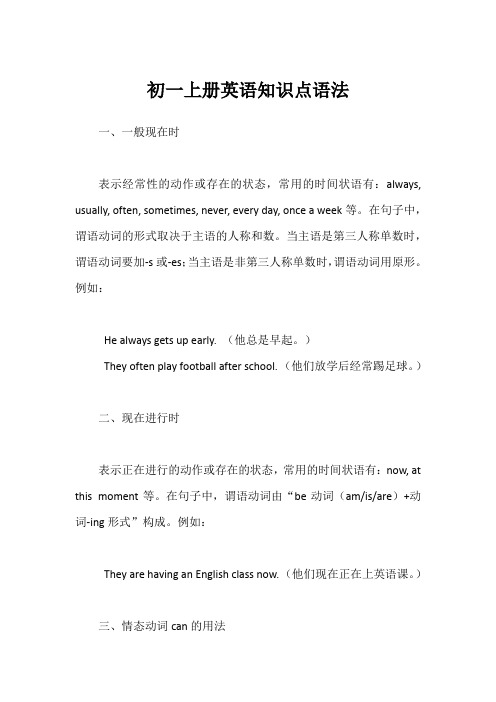
初一上册英语知识点语法一、一般现在时表示经常性的动作或存在的状态,常用的时间状语有:always, usually, often, sometimes, never, every day, once a week等。
在句子中,谓语动词的形式取决于主语的人称和数。
当主语是第三人称单数时,谓语动词要加-s或-es;当主语是非第三人称单数时,谓语动词用原形。
例如:He always gets up early. (他总是早起。
)They often play football after school. (他们放学后经常踢足球。
)二、现在进行时表示正在进行的动作或存在的状态,常用的时间状语有:now, at this moment等。
在句子中,谓语动词由“be动词(am/is/are)+动词-ing形式”构成。
例如:They are having an English class now. (他们现在正在上英语课。
)三、情态动词can的用法can表示能力或许可,后面跟动词原形。
例如:Can you swim? (你会游泳吗?)You can't play football in the classroom. (你们不能在教室里踢足球。
)四、动词be的用法be动词有三种形式:am, is, are。
主语是第一人称单数时用am;主语是第三人称单数时用is;主语是第二人称或复数时用are。
be动词与后面的表语一起构成系表结构,表示主语的状态或特征。
例如:I am a student. (我是一名学生。
)He is tall and thin. (他又高又瘦。
)五、代词初一上册英语中涉及到的代词有人称代词、物主代词、指示代词等。
学生需要掌握这些代词的用法和区别。
例如:人称代词:I, you, he, she, it, we, they等。
物主代词:my, your, his, her, its, our, their等。
初一上册英语语法知识点归纳
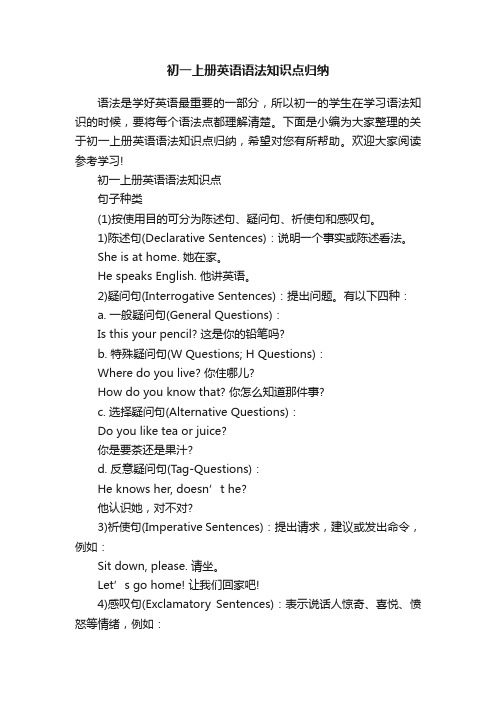
初一上册英语语法知识点归纳语法是学好英语最重要的一部分,所以初一的学生在学习语法知识的时候,要将每个语法点都理解清楚。
下面是小编为大家整理的关于初一上册英语语法知识点归纳,希望对您有所帮助。
欢迎大家阅读参考学习!初一上册英语语法知识点句子种类(1)按使用目的可分为陈述句、疑问句、祈使句和感叹句。
1)陈述句(Declarative Sentences):说明一个事实或陈述看法。
She is at home. 她在家。
He speaks English. 他讲英语。
2)疑问句(Interrogative Sentences):提出问题。
有以下四种:a. 一般疑问句(General Questions):Is this your pencil? 这是你的铅笔吗?b. 特殊疑问句(W Questions; H Questions):Where do you live? 你住哪儿?How do you know that? 你怎么知道那件事?c. 选择疑问句(Alternative Questions):Do you like tea or juice?你是要茶还是果汁?d. 反意疑问句(Tag-Questions):He knows her, doesn’t he?他认识她,对不对?3)祈使句(Imperative Sentences):提出请求,建议或发出命令,例如:Sit down, please. 请坐。
Let’s go home! 让我们回家吧!4)感叹句(Exclamatory Sentences):表示说话人惊奇、喜悦、愤怒等情绪,例如:What good news it is! 多好的消息啊!初一英语必备语法知识单数句变复数句1. 可数名词单数要变为其相应的复数形式。
It is a box.→ They are boxes.2. 各个人称代词要由单数形式变为复数形式。
She is a girl.→ They are girls. I am at home.→ We are at home.3. am或is 要变为are.He is a teacher. → They are te achers.4. 指示代词this或that要分别变为these或those。
七年级上册英语语法总结

七年级上册英语语法总结英语语法总结一、词类(Parts of Speech)1. 名词(Nouns)- 表示人、事物、地点和抽象概念。
根据单数和复数、可数和不可数等特征可分为多种类型。
2. 代词(Pronouns)- 代替名词的词语,如人称代词、指示代词、不定代词等。
3. 形容词(Adjectives)- 描述名词的特征和性质,常用于修饰名词。
4. 动词(Verbs)- 表示动作、状态或感觉的词语,可分为谓语动词和助动词等。
5. 副词(Adverbs)- 修饰动词、形容词、副词等,用于表示程度、方式、时间等。
6. 冠词(Articles)- 用于限定名词的特定性,分为不定冠词(a/an)和定冠词(the)。
7. 介词(Prepositions)- 表示位置、关系等,通常和名词、代词等连用。
8. 连词(Conjunctions)- 连接句子、短语或单词之间的关系,如并列连词、从属连词等。
9. 感叹词(Interjections)- 表示情绪、惊奇等,常用于句子中的感叹部分。
二、句子结构(Sentence Structure)1. 主语(Subject)- 句子中进行动作或被描述的对象,通常是名词或代词。
2. 谓语(Predicate)- 句子中用来说明主语动作、状态的部分,通常是动词。
3. 宾语(Object)- 句子中接收动作的对象,通常是名词、代词或动名词。
4. 定语(Adjective)- 用来修饰名词的词语,可以是形容词、限定从句等。
5. 状语(Adverbial)- 用来修饰动词、形容词或副词的词语,可以表示时间、地点、方式等。
6. 句子成分(Sentence Elements)- 包括主语、谓语、宾语、定语和状语。
三、时态和语态(Tenses and Voice)1. 一般现在时(Simple Present)- 表示经常性、习惯性或客观真理。
2. 一般过去时(Simple Past)- 表示过去发生的动作或状态。
初一英语上册语法知识点总结
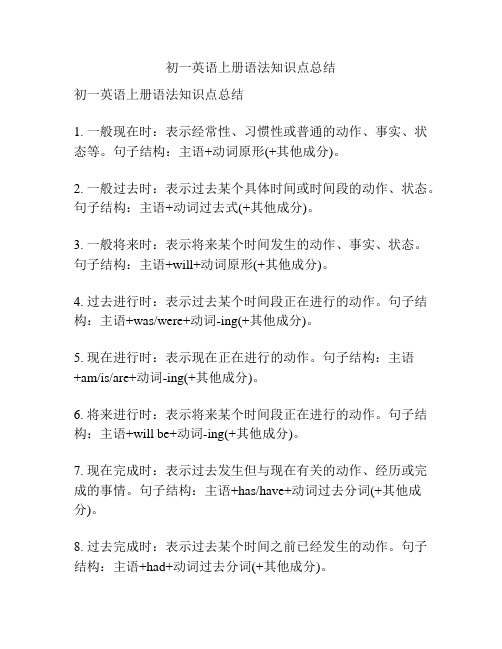
初一英语上册语法知识点总结初一英语上册语法知识点总结1. 一般现在时:表示经常性、习惯性或普通的动作、事实、状态等。
句子结构:主语+动词原形(+其他成分)。
2. 一般过去时:表示过去某个具体时间或时间段的动作、状态。
句子结构:主语+动词过去式(+其他成分)。
3. 一般将来时:表示将来某个时间发生的动作、事实、状态。
句子结构:主语+will+动词原形(+其他成分)。
4. 过去进行时:表示过去某个时间段正在进行的动作。
句子结构:主语+was/were+动词-ing(+其他成分)。
5. 现在进行时:表示现在正在进行的动作。
句子结构:主语+am/is/are+动词-ing(+其他成分)。
6. 将来进行时:表示将来某个时间段正在进行的动作。
句子结构:主语+will be+动词-ing(+其他成分)。
7. 现在完成时:表示过去发生但与现在有关的动作、经历或完成的事情。
句子结构:主语+has/have+动词过去分词(+其他成分)。
8. 过去完成时:表示过去某个时间之前已经发生的动作。
句子结构:主语+had+动词过去分词(+其他成分)。
9. 句子的陈述语序为:主语+谓语(+宾语/+宾补/+宾语+宾补)。
10. 句子的一般疑问句语序为:助动词/情态动词+主语+谓语(+其他成分)?11. be动词及情态动词的否定形式:在动词前加not。
12. 可数名词:可以数出来的名词,有单数和复数形式。
13. 不可数名词:不能数出来的名词,通常表示整体、无法分割的事物。
14. 形容词的比较级和最高级:比较级用于两者之间的比较,最高级用于三者或三者以上之间的比较。
15. 物主代词:用来表示所属关系的代词,有形容词性物主代词和名词性物主代词两种形式。
16. 反身代词:表示动作施于自己的代词。
17. 句子的主谓一致:主语和谓语在人称和数上保持一致。
18. 介词:表示时间、地点、方式、方向等意义的词,通常放在名词之前。
19. 动词的时态:动词根据时间的不同有不同的时态,包括一般时态、进行时态、完成时态等。
初一上册英语语法大全

1.现在进⾏时:主语+am/is/are doing We are cleaning the room now. 现在进⾏时:am(not)/is(n't)/are(n't)+V.ing 2.过去进⾏时:was/were doing .We were cheaning the room at 5:00 yesterday afternoon. 过去进⾏时:was(n't)/were(n't)+V.ing 3.⼀般现在时:主语+do/does(现在分词) We clean the room every day. ⼀般现在时:do(n't)/does(n't) 4.⼀般过去时:主语+did We cleaned the room just now. ⼀般过去式:did(n't)+V.原 5.现在完成时: have/has done We have cleaned the room already. 现在完成时:have(n't)/has(n't)+过去分词(p.p.) 6.过去完成时: had done We had cleaned the room before he arrived. 过去完成时:had+p.p. 7.⼀般将来时: will do/ We will clean the room tomorrow. ⼀般将来时:will(not)+V.ing / is(n't)/are(n't)+going to +V.原 8.过去将来时: was/were to /would do He said he would clean the room next 过去将来时:would(n't) / was(n't)/were(n't)+V.原 动词不定式:to+V.ing ⼀、⼀般现在时: 概念:经常、反复发⽣的动作或⾏为及现在的某种状况。
七年级上册英语语法归纳

七年级上册英语语法归纳以下是七年级上册英语语法归纳:
一、一般现在时
1. 表示经常发生的动作或存在的状态。
2. 表示主语具备的性格和能力。
3. 表示客观事实或普遍真理。
4. 表示计划或打算将来发生的动作。
二、一般过去时
1. 表示过去某个时间发生的动作或存在的状态。
2. 表示过去经常发生的动作。
3. 描述客观事实或过去的经验。
三、现在进行时
1. 表示现在正在进行的动作。
2. 表示现阶段正在进行的活动或现阶段存在的状态。
3. 表示即将发生的动作。
4. 与 always、forever、continually 等词连用表示情感等。
四、动词不定式
1. 做定语:放在名词后面,表示抽象概念。
2. 做主语:表示未来动作,用 to do 表示;表示泛指或已知信息,用doing 表示。
3. 做宾语:常放在动词或介词后面。
4. 做目的状语:表示为了什么而做某事。
5. 做宾语补足语:表示宾语的具体内容或动作的结果等。
五、动词的-ing 形式
1. 做定语:修饰名词,表示正在进行的动作或状态。
2. 做主语:表示抽象概念或泛指,也可以表示已知信息。
3. 做宾语:放在动词或介词后面,表示正在进行的动作或状态。
4. 做表语:放在系动词后面,表示主语的状态或特征等。
5. 做状语:表示时间、原因、结果、伴随等关系。
以上是七年级上册英语语法重点归纳,同学们需要掌握这些语法点,以便更好地理解英语句子和表达自己的意思。
初一英语上册语法总结
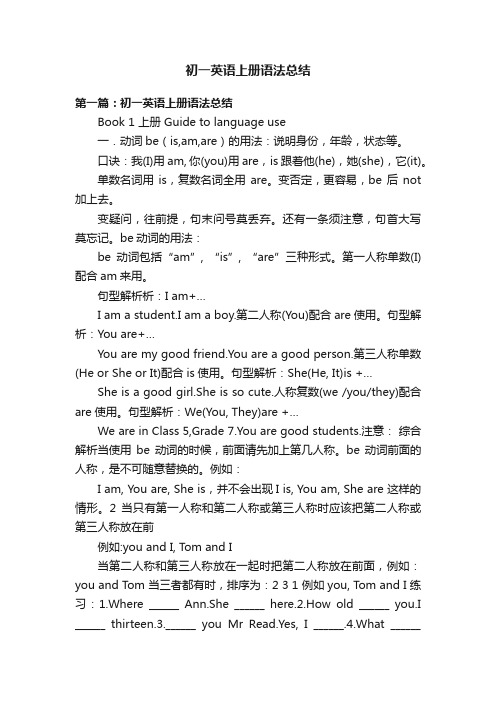
初一英语上册语法总结第一篇:初一英语上册语法总结Book 1 上册 Guide to language use一.动词be(is,am,are)的用法:说明身份,年龄,状态等。
口诀:我(I)用am, 你(you)用are,is跟着他(he),她(she),它(it)。
单数名词用is,复数名词全用are。
变否定,更容易,be后not 加上去。
变疑问,往前提,句末问号莫丢弃。
还有一条须注意,句首大写莫忘记。
be动词的用法:be动词包括“am”, “is”, “are”三种形式。
第一人称单数(I)配合am来用。
句型解析析:I am+…I am a student.I am a boy.第二人称(You)配合are使用。
句型解析:You are+…You are my good friend.You are a good person.第三人称单数(He or She or It)配合is使用。
句型解析:She(He, It)is +…She is a good girl.She is so cute.人称复数(we /you/they)配合are使用。
句型解析:We(You, They)are +…We are in Class 5,Grade 7.You are good students.注意:综合解析当使用be动词的时候,前面请先加上第几人称。
be动词前面的人称,是不可随意替换的。
例如:I am, You are, She is,并不会出现I is, You am, She are 这样的情形。
2 当只有第一人称和第二人称或第三人称时应该把第二人称或第三人称放在前例如:you and I, Tom and I当第二人称和第三人称放在一起时把第二人称放在前面,例如:you and Tom 当三者都有时,排序为:2 3 1 例如you, Tom and I 练习:1.Where ______ Ann.She ______ here.2.How old ______ you.I ______ thirteen.3.______ you Mr Read.Yes, I ______.4.What ______your name.My name ____ Ann二情态动词Can can作“能、会”解,否定式是cannot,缩写为can’t。
七年级英语上册语法总结归纳

七年级英语上册语法总结归纳
七年级英语上册语法总结归纳如下:
1. 一般现在时:表示经常发生的动作或存在的状态。
- 肯定句:主语+动词原形+其他
- 否定句:主语+don't/doesn't+动词原形+其他
- 疑问句:Do/Does+主语+动词原形+其他
2. 现在进行时:表示正在发生的动作。
- 肯定句:主语+am/is/are+动词 ing+其他
- 否定句:主语+am/is/are+not+动词 ing+其他
- 疑问句:Am/Is/Are+主语+动词 ing+其他
3. 一般过去时:表示过去发生的动作或存在的状态。
- 肯定句:主语+动词过去式+其他
- 否定句:主语+didn't+动词原形+其他
- 疑问句:Did+主语+动词原形+其他
4. 可数名词和不可数名词:可数名词有单数和复数形式,不可数名词没有复数形式。
5. 冠词:分为定冠词 the 和不定冠词 a/an。
6. 形容词和副词:形容词修饰名词,副词修饰动词、形容词和其他副词。
7. 介词:表示时间、地点、方位等关系的词。
8. 简单句:由一个主语和一个谓语构成的句子。
9. 并列句:由两个或两个以上简单句用连词连接而成的句子。
10. 复合句:由一个主句和一个或一个以上的从句构成的句子。
七上英语语法知识点归纳总结
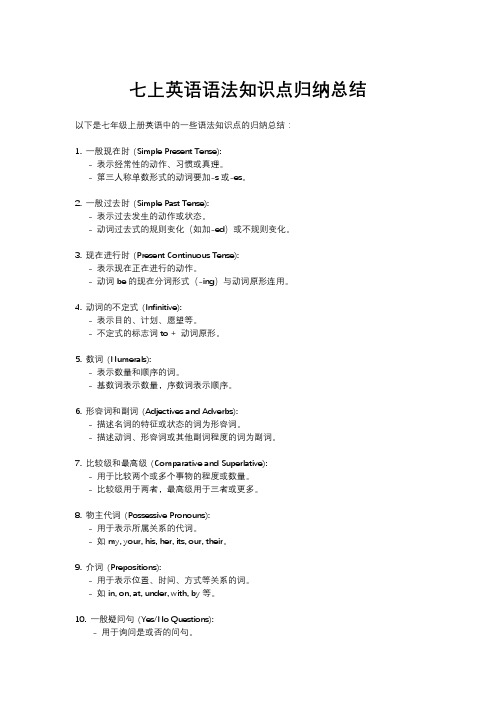
七上英语语法知识点归纳总结以下是七年级上册英语中的一些语法知识点的归纳总结:1. 一般现在时(Simple Present Tense):- 表示经常性的动作、习惯或真理。
- 第三人称单数形式的动词要加-s或-es。
2. 一般过去时(Simple Past Tense):- 表示过去发生的动作或状态。
- 动词过去式的规则变化(如加-ed)或不规则变化。
3. 现在进行时(Present Continuous Tense):- 表示现在正在进行的动作。
- 动词be的现在分词形式(-ing)与动词原形连用。
4. 动词的不定式(Infinitive):- 表示目的、计划、愿望等。
- 不定式的标志词to + 动词原形。
5. 数词(Numerals):- 表示数量和顺序的词。
- 基数词表示数量,序数词表示顺序。
6. 形容词和副词(Adjectives and Adverbs):- 描述名词的特征或状态的词为形容词。
- 描述动词、形容词或其他副词程度的词为副词。
7. 比较级和最高级(Comparative and Superlative):- 用于比较两个或多个事物的程度或数量。
- 比较级用于两者,最高级用于三者或更多。
8. 物主代词(Possessive Pronouns):- 用于表示所属关系的代词。
- 如my, your, his, her, its, our, their。
9. 介词(Prepositions):- 用于表示位置、时间、方式等关系的词。
- 如in, on, at, under, with, by等。
10. 一般疑问句(Yes/No Questions):- 用于询问是或否的问句。
- 助动词do/does/did + 主语+ 动词原形。
这些是七年级上册英语中的一些基础语法知识点。
通过掌握这些知识,您将能够更好地理解和运用英语语法规则,提高英语表达能力。
请注意,这只是一些常见的语法知识点,还有其他更复杂的语法规则和用法需要进一步学习和掌握。
七年级英语上册语法学习知识点总结

七年级英语上册语法学习知识点总结初一英语语法虽然是从简单的一些日常用语出发的,但语法中常会有一些知识点看起来很细小,容易被忽视,但这些知识点掌握不熟练,往往会造成一些语法应用上的错误。
下面是小编给大家带来的七年级英语上册语法学习知识点总结,希望能够帮助到大家!七年级英语上册语法学习知识点总结一、初一英语语法——词法1、名词A)、名词的数我们知道名词可以分为可数名词和不可数名词,而不可数名词它没有复数形式,但可数名词却有单数和复数之分,复数的构成如下:一)在后面加s。
如:fathers, books, Americans, Germans, apples, bananas二)x, sh, ch, s, tch后加es。
如:boxes, glasses, dresses, watches, wishes, faxes三)1)以辅音字母加y结尾的变y为i再加es 如:baby-babies, family-families, duty-duties, comedy-comedies, documentary-documentaries, story-stories2)以元音字母加y结尾的直接加s。
如:day-days, boy-boys, toy-toys, key-keys, ways四)以o结尾加s(外来词)。
如:radios, photos, 但如是辅音加o 的加es:如: tomatoes西红柿, potatoes马铃薯五)以f或fe结尾的变f为v再加es(s)。
如:knife-knives, wife-wives, half-halves, shelf-shelves, leaf-leaves, yourself-yourselves六)单复数相同(不变的)有:fish, sheep, deer鹿子, Chinese, Japanese七)一般只有复数,没有单数的有:people,pants, shorts, shoes, glasses, gloves, clothes, socks八)单词形式不变,既可以是单数也可以是复数的有:police警察局,警察, class班,同学, family家,家庭成员九)合成的复数一般只加主要名词,多数为后一个单词。
新人教版七年级上册英语语法、短语和知识点总结

新人教版七年级上册英语语法、短语和知
识点总结
一、语法部分
1. 一般现在时
- 用于表达经常性、惯性的动作或状态。
- 谓语动词用基本形式。
2. 一般过去时
- 用于表达过去发生的动作或状态。
- 谓语动词用过去式。
3. 现在进行时
- 用于表达现在正在进行的动作。
- 谓语动词由“be”动词的相应形式与现在分词构成。
4. 动词不定式
- 作为名词、形容词或副词的补足语。
- 用于表达目的、原因、结果等。
二、短语部分
1. in front of
- 在...前面
2. on the right/left
- 在右边/左边
3. at the back of
- 在...后面
4. go straight
- 直走
三、知识点部分
1. 单复数
- 名词的复数形式变化规则。
2. 冠词
- a/an 用于泛指单数可数名词前。
- the 用于特指名词前。
3. 人称代词
- I, you, he, she, it, we, they。
4. 并列连词
- and, but, or 用于连接并列的词、短语或句子。
四、总结
本文档总结了新人教版七年级上册英语课程中的语法、短语和
知识点。
内容包括一般现在时、一般过去时、现在进行时等语法部分,以及一些常用短语和知识点。
希望对研究者有所帮助。
以上是对新人教版七年级上册英语语法、短语和知识点的总结。
注意:
本文档中的内容仅供参考。
七年级上册语法知识点总结

千里之行,始于足下。
七年级上册语法知识点总结
七年级上册的语法知识点主要包括以下内容:
1. 名词:名词的基本用法、可数和不可数名词、单数和复数形式等。
2. 代词:人称代词、物主代词、反身代词的用法与形式。
3. 冠词:不定冠词a/an的用法,定冠词the的用法。
4. 形容词:形容词的用法、比较级和最高级形式。
5. 副词:副词的基本用法、方式副词、时间副词等。
6. 动词:动词的基本用法、动词的时态、动词的被动语态、情态动词等。
7. 数词:基数词和序数词的用法。
8. 介词:介词的基本用法、常见的介词短语。
9. 连词:并列连词、从属连词等。
10. 句子成分:主语、谓语、宾语、表语、定语、状语等。
11. 句型:陈述句、疑问句、祈使句、感叹句等。
12. 时态:一般现在时、一般过去时、一般将来时等。
第1页/共2页
锲而不舍,金石可镂。
13. 被动语态:被动语态的构成和用法。
14. 直接引语和间接引语:直接引语和间接引语的转换。
15. 各种句式和翻译。
以上是七年级上册的主要语法知识点总结,希望对你有帮助!。
英语七年级上册语法总结

Sunday..
Where do you play games on
①总则:主语是第三人称单数时;动词谓语要用三单式..如:
He gets up at six.. 由于主语 He 是第三人称单数;动词 get 后要 s;
即 gets 是三单式..
②可以作第三人称单数主语三单主语的有:1he; she;it;2 单个的人;
单个的物..
③动词三单式的构成
1 特殊的:be—is have—has
2 有规律的:1 大部分在词尾加 s; 如:
get—gets take--takes need-needs know—knows
2 以 s; x;ch; sh;o 结尾的加 es; 如:
guess—guesses 猜 watch--watches 看 teach―teaches 教 fish-
fishes 钓鱼 go-goes 去 do-does
英语七年级上册语法总结
Ability is not the only criterion, but character is the criterion.
七
年
级
语
法
总
结
1、目前所学的动词的形式有 4 种:
①动词原形;如:do;have;like
②动词的单三式常在动词原形后加 s;如:get-gets
姓名等问宾 Whom can you ask the question
语
问人的职业 He is a worker. What is he
或事物是什 He has a book. What does he
么
have
问一定范围 The big box is mine. Which box
- 1、下载文档前请自行甄别文档内容的完整性,平台不提供额外的编辑、内容补充、找答案等附加服务。
- 2、"仅部分预览"的文档,不可在线预览部分如存在完整性等问题,可反馈申请退款(可完整预览的文档不适用该条件!)。
- 3、如文档侵犯您的权益,请联系客服反馈,我们会尽快为您处理(人工客服工作时间:9:00-18:30)。
初一上册英语语法总结一、动词be(is,am,are)的用法:口诀:我(I)用am, 你(you)用are,is跟着他(he),她(she),它(it)。
单数名词用is,复数名词全用are。
变否定,更容易,be后not加上去。
变疑问,往前提,句末问号莫丢弃。
还有一条须注意,句首大写莫忘记。
be动词包括“am”, “is”, “are”三种形式。
1)第一人称单数(I)配合am来用。
句型解析析:I am+…例:I am a student . I am a boy.2)第二人称(You)配合are使用。
句型解析:You are+…例:You are my good friend. You are a good person.3)第三人称单数(He or She or It)配合is使用。
句型解析:She(He, It) is +…例:She is a good girl. It is so big.4)人称复数(we /you/they)配合are使用。
句型解析:We (You, They) are +…5)We are in Class 5,Grade 7. You are good students.注意:1、使用be动词的时候,前面要先加上人称。
be动词前面的人称,是不可随意替换的。
例如:I am, You are, She is,并不会出现I is, You am, She are 这样的情形。
2、当只有第一人称和第二人称或第三人称时应该把第二人称或第三人称放在前例如:you and I, Tom and I当第二人称和第三人称放在一起时把第二人称放在前面,例如:you and Tom当三者都有时,排序为:2 3 1练习:Where ______ Ann ?She ______ here.How old ______ you ?I ______ thirteen.______ you Mr Read?Yes, I ______.What ______ your name?My name ____ Ann.二、情态动词Can1 、can作“能、会”解,否定式是cannot,缩写为can’t。
“can+动词原形” “can’t+动词原形” :表示某人能做或不能做某事Can 是情态动词,没有人称和数的变化。
Can 表示的”能力”为现在的能力,而不是过去或将来的能力。
1).表示能力。
例如:—Can you write in English? —Yes, I can.I can run fast,can you?2).表示获得的知识或技能。
例如:—Can she speak Japanese? —No, she can’t.她会说日语吗?不,她不会。
3).表示许可。
例如:Can I read your newspaper?我能看看你的报纸吗?Can I take you home?我送你回家行吗?We can’t wear jeans at work.我们上班时不准穿牛仔裤。
4). 表示要求。
例如:Can you help me with this box?你能帮我弄这个箱子吗?Can you feed the cat?你喂喂猫好吗?5). 表示可能性。
例如:That can’t be Mary—she’s in hospital.那不可能是玛丽—她住院了。
He can’t have slept through all that noise.那么吵他不可能睡得着觉。
There’s someone outside—who can it be?外面有人—会是谁呢?6).用以提出建议。
例如:We can eat in a restaurant, if you like.你愿意的话,咱们可以在饭馆吃饭。
I can take the car if necessary.必要时我可以开车去。
2、句式变化如下:1. 在变否定句时,直接在can后加上“not”,可缩写成can’t或cannot, 但不能写成cann’t。
例如:He can swim. → He can’t swim.Emma can see the pen on the desk.→ Emma cannot see the pen on the desk.2. 在变一般疑问句时,直接移到主语前(原主语的首字母改成小写,第一人称应变为第二人称)即可。
例如:I can see an orange on the table. → Can you see an orange on the table?其回答可用Yes, OK或Certainly等作肯定回答;用No或Sorry等作否定回答。
例如:—Can you look after my books, please? 你能照看一下我的书吗?—OK. 可以。
用Certainly回答。
此时语气更为肯定。
例如:—Can I see your guitar? 我能看看你的吉它吗?—Certainly. 当然可以。
练习:1 -Can you speak Japanese? -No, I___.A. mustn'tB. can'tC. needn'tD. may not2、I can play basketball.(变为一般疑问句,并作回答)Play basketball?Yes, .No, .三、“there be”句型(1)There be句型主要用以表达“某处(某时)有某人(某物)。
基本结构为“There be+某物(某人)+某地(某时)”其中there是引导词,没有词义;主语是be后面的名词,be是谓语动词,在一般现在时中be只用is和are两种形式。
(2)There be句型中的be动词如何确定呢?请先看看下面这首歌诀:Be动词,有三个,am,is还有are。
“There be”真特别,不留am只留俩,那就是is还有are。
要用is还是are,须看其后的名词是单数还是复数。
若是单数或不可数名词用is,否则就用are。
如:①There is a tree behind the house.②There is some water(水)in the bottle(瓶子).③There are some pears in the box.(3)注意:如果“be”后的主语是由and连接的两个或两个以上的名词,那么be的形式要遵循“远亲不如近邻”的原则。
也就是说,“be”的形式是由与它最近的那个名词来确定的。
若那个名词是单数或不可数名词要用is,是复数就用are。
如:①There is a book and some pens on the floor.②There are some pens and a book on the floor.(4)There be句型的三种句式1)否定句There be句型的否定式的构成和含有be动词的其它句型一样,在be后加上not即可。
例如:There are some pictures on the wall. →There aren't any pictures on the wall.There is a bike behind the tree. → There isn't a bike behind the tree.2)一般疑问句There be句型的一般疑问句变化是把be动词调整到句首,再在句尾加上问号即可。
但同时要注意:当肯定句中有some时,要将其改为any(否定变化也一样)。
例如:There is some water on Mars. → Is there any water on Mars?There are some fish in the water. →Are there any fish in the water?练习:1、1.There ________ a bed and a big wardrobe with a mirror.A.are B.were C.was D.be2、There are some children in the garden.(变为一般疑问句和否定句)there children in the garden?There children in the garden.四、冠词a 与an 的用法a 与an表示“一个”。
a 用在辅音音素开头的可数名词单数前;an用在以元音音素开头的可数名词单数前。
例如: an apple a CD练习:(1)There is “U”in the word.A aB anC the D/(2)This is pen. pen is green.A a;TheB a; /C the ;/D the;The(3)Do you have basketball? Let’s play basketball.A an;aB a;aC /;/D a; /(4)I have apple.A aB anC muchD many(5)“What’s this in English ?”“It’s orange.”A aB theC anD /(6)It takes me hour to school every day.A aB anC theD /(7)---Do you have eraser?---Yes, I have.A anB aC theD /五、指示代词的形式与用法英语中的指示代词主要的有this(这个), that(那个), these(这些), those(那些),其中this和that为单数,these和those为复数;this和these为近指,that和those为远指。
例句:This is a very useful book. 这是一本很有用的书。
I don’t like that man. 我喜欢那个人。
I like these and he likes those. 我喜欢这些,他喜欢那些。
【注】在打电话时,通常用this 指自己,用that 指对方:例句:Hello. This is Mary. Is that Jim? 喂,我是玛丽,你是吉姆吗?练习:一、填空1. I like _____ pants. _______ pants are red.(这些)2. I don’t like ____ shoes. ____shoes are too small.(那些)3. I want _____(这个) sweater. I don’t want________(那个)sweater._____ (那个)is too big.二、选择。
